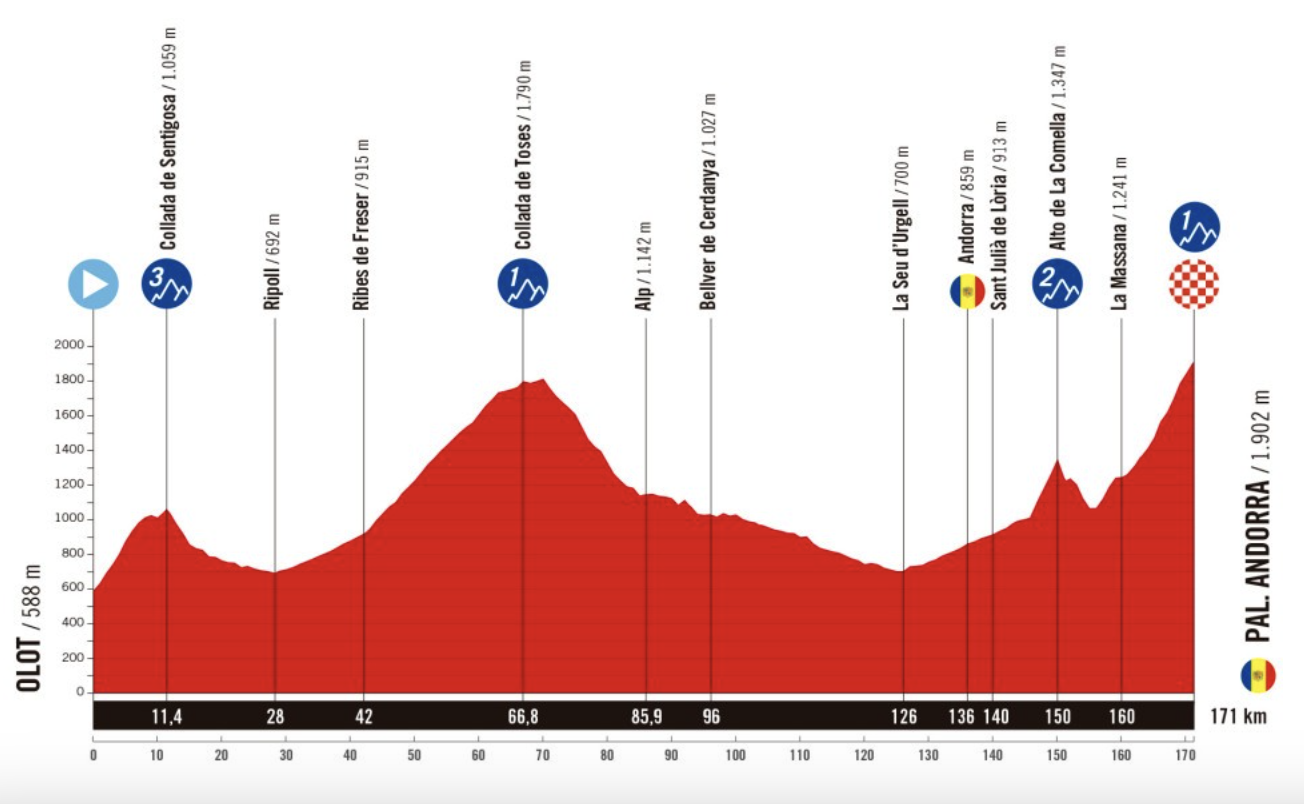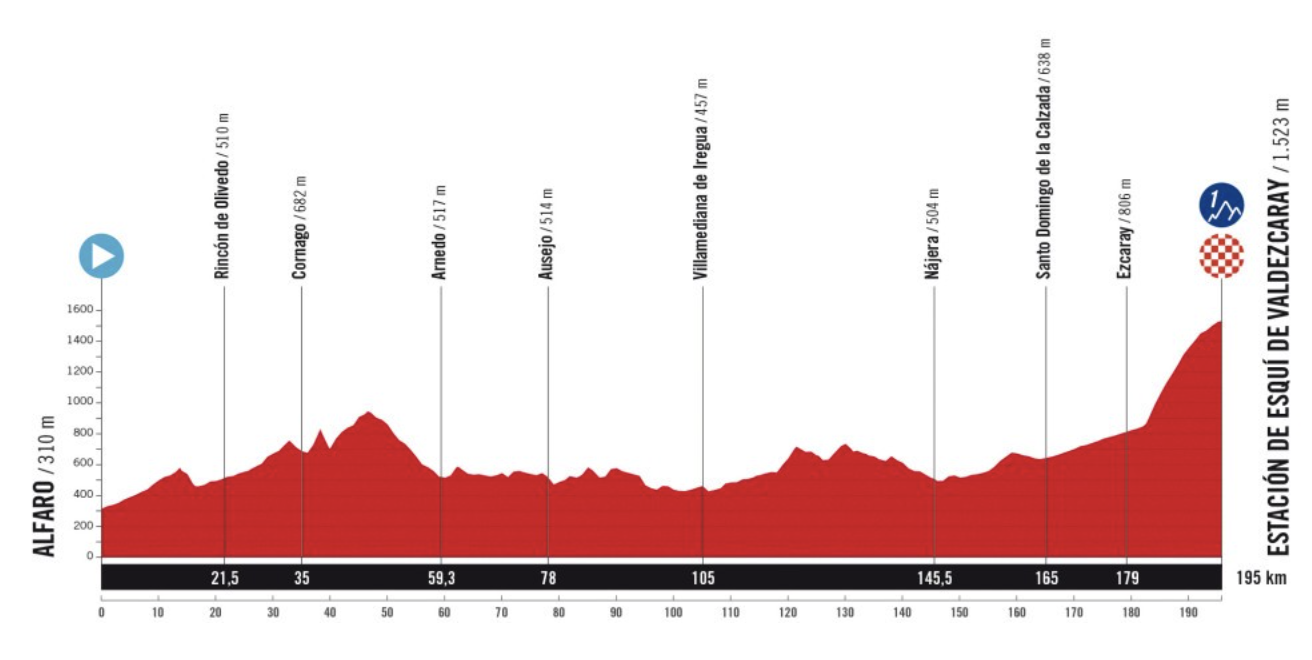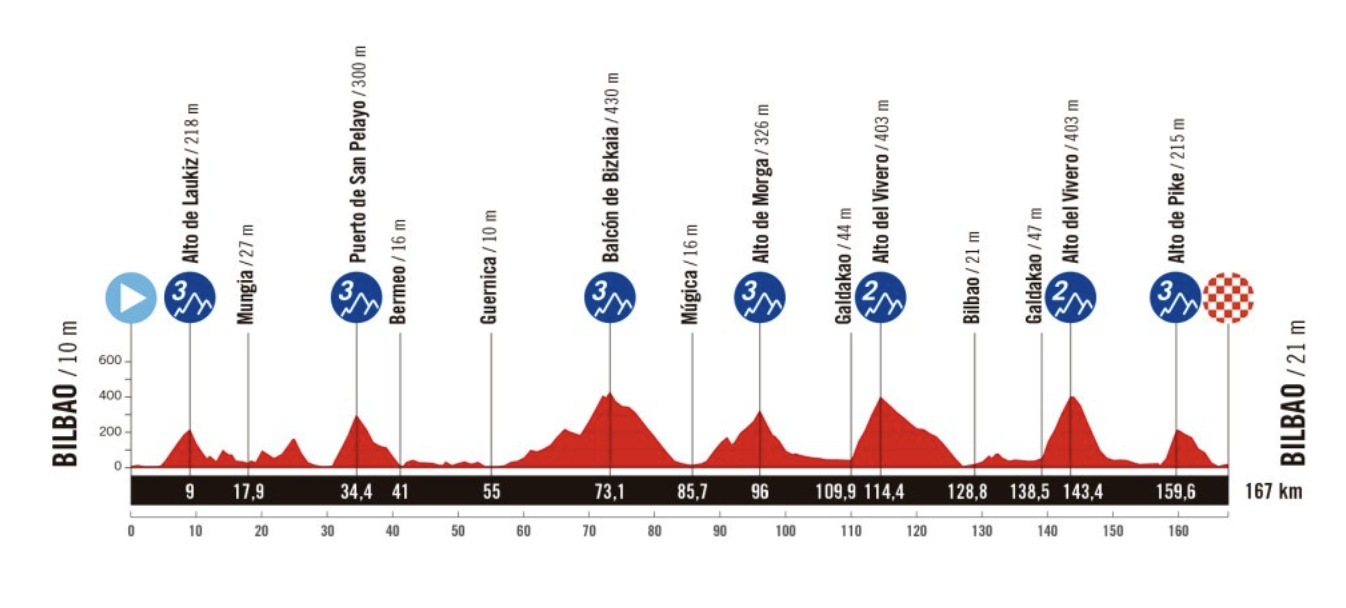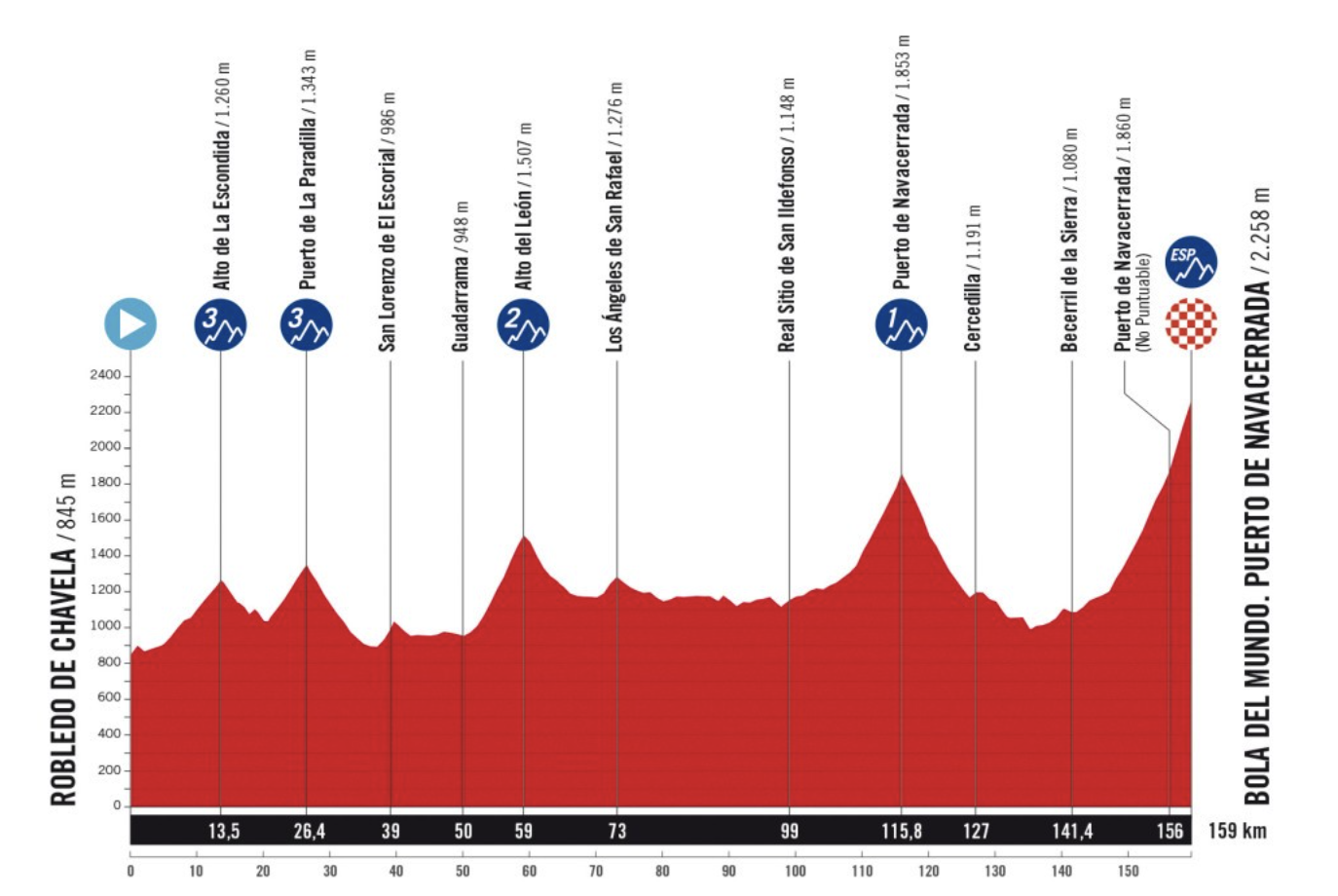
The 2025 Vuelta a España route looks tailor-made for a possible participation of Tadej Pogačar with 10 summit finishes, an ascent of the mythical Angliru and a long, late individual time trial, all components that could attract the UAE Team Emirates champion.
Revealed on Thursday evening in Madrid's IFEMA trade and congress centre, the 2025 Vuelta a España also kicks off for the first time in Italy and – almost equally as unusual – features a team time trial midway through the first week.
But as so often happens with the Vuelta, the GC battle will begin in earnest once the race hits the high mountains. The overall contenders face crunch uphill challenges as soon as stage 6 to the category 1 finish at Pal in Andorra, although the race's emotional and climbing highpoint will doubtless come on stage 13, with the summit finish of the mythical Angliru.
Yet more historic elements feature in the 2025 route, like stage 18's individual time trial in Valladolid, a city steeped in Vuelta time trial history and with victories against the clock by champions of the calibre of Tony Rominger, Bernard Hinault and Raymond Poulidor. And the inclusion of another hugely emblematic summit finish, the Bola del Mundo, just 24 hours before the finish in Madrid, could also help Pogačar opt for the Vuelta a España over a return to the Giro d'Italia next season.
Striking a markedly international note for its 80th edition, the Vuelta visits a record-equalling four countries in 2025, getting underway in Turin, Italy on August 23, before going to France, Andorra and, of course, Spain. The Vuelta has not visited so many countries since 2009, when the race began in Assen, Holland, then briefly visited Germany on stage 3 and Belgium on stage 4 before returning to home soil.
Italy's opening series of four flat and hilly stages next August, though, will not likely produce major differences between the main contenders. And even after a transfer back through France, the flat 20-kilometre team time trial in Figueres on stage 5, while a firm fan favourite, will arguably not open up large GC gaps, either.
However, a first major summit finish at Pal in Andorra on stage 6, an even tougher Pyrenean stage to Cerler the following day, and another well-known Vuelta summit finish at Valdezcaray on stage 9 could well prove much more significant long term. Then the second week kicks off with a bang, too, with a return to Larra-Belagua in the Pyrenees, the scene of Remco Evenepoel's revenge victory in the 2023 Vuelta after his defeat on the Tourmalet just 24 hours earlier.
Both the hilly stage 11 around Bilbao and the category 1 ascent late on the stage to Corrales de Buelna the following day, could see more GC action. But it is the Angliru, back on the menu for the third time in five years on stage 13, which will doubtless be the climbing star of the Vuelta show next summer.
First introduced in 1999, ever since then the 12.5 kilometre, narrow, poorly-surfaced and agonisingly steep ascent has produced some epic GC battles. For Pogačar, winning on the 10th ascent of the Vuelta's best-known and most daunting climb - and where his idol Alberto Contador brought down the curtain on his career with a stunning solo win in 2017 - would surely represent yet another major high point in his already glittering palmares.
Rather than the Angliru providing a definitive GC hierarchy, though, there's plenty more in store in the Vuelta's last eight stages. Hard on the heels of the Angliru, the 2025 Vuelta peloton will ascend the nearby Alto de Farrapona on stage 14 - where Alberto Contador delivered yet another body blow to Chris Froome's hopes of victory in 2014.
Albeit on radically different terrain, Valladolid's flat 26-kilometre time trial across the exposed plains of northern Spain on stage 18 will also give the GC leader another important setpiece opportunity to stretch out his overall advantage.
Last but not least, the Bola del Mundo on stage 20, an ascent featuring ramps of up to 20% on cement trackways and peaking out at over 2,200 metres above sea level, will provide the last major, challenge for whoever is leading the Vuelta.
The Vuelta then switches back to its roots again on stage 21, with a largely ceremonial ride through the streets of the capital city, likely culminating in a bunch sprint, and perhaps Pogačar first-ever overall victory in Spain's Grand Tour.
Stage 1: Torino to Reggia di Venaria - Novara, 183km

The Vuelta's Grande Partenza gets underway in Turin, a first-ever Italian start for the Spanish Grand Tour. It's also the first opportunity for sprinters to take the lead on the opening day of the Vuelta since 2007, when, as it happens, an Italian fastman – Daniele Bennati – won in Vigo.
- Km 64.1: Cat. 3 - Puerto Bienca Tomalino
Stage 2: Alba - Puerto Limone, 157km

The Vuelta's first summit finish of 10, but not the hardest by far, particularly on such a short stage. Limone Piemonte is a relatively benign 5% average gradient over 10km, so expect a small group sprint, and perhaps one or two pre-race favourites to come unstuck.
- Km 157: Cat. 2 - Limone Piemonte
Stage 3: San Maurizio Canavese to Ceres - 139km

The third and final stage run off completely in Italy, and one which should favour the breakaways, given the mid-race cat.2 climb and the technical, sinuous nature of the terrain.
- Km 65. 2: Cat.2 - Puerto Issiglio
Stage 4: Susa to Voiron - 192km

From Italy into France across the Alps, but unlike in the 2024 Tour when the race went over the Galibier, this much more straightforward cross-frontier route will likely see the strongest sprinters making it over the long, relatively easy early climbs in a large front group and a second bunch sprint materialize in Voiron.
- Km 10.4: Cat. 3 - Puerto Exiles
- Km 37.6: Cat.2 - Col de Montgenevre
- Km 76.6: Cat.2 - Col du Lauteret
Stage 5: Figueres to Figueres (TTT) - 20km

First week medium-distance team time trials in Grand Tours are increasingly uncommon, but this one could see the strongest specialist squads like UAE and Visma gain ground on their weakest rivals. No categorized climbs, but the uphill finish could cause some trouble.
Stage 6: Olot to Pal. Andorra - 171km

Into the Pyrenees for the first major mountain stage of 2024. Many of the riders who are residents in Andorra will know the finale in Pal, last used by the Vuelta in 2010, and it should create some significant differences on GC.
- Km 11.4: Cat.3 - Collada de Sentigosa
- Km 66.8: Cat.1 - Collada de Toses
- Km 150: Cat.2 - Alt de la Comella
- Km 171: Cat. 1 - Pal
Stage 7: Andorra la Vella.Andorra to Cerler.Huesca La Magia - 187km

A second full-on Pyrenean stage in as many days, starting with the fearsomely long, irregular Port de Cantó as an opening challenge and culminating in the ascent to Cerler. A regular feature in the 19990s Vueltas, Cerler is much tougher in the first half, but more than enough in in total to create some more significant GC gaps.
- Km 37.9: Cat.1 - Port del Cantó
- Km 107.7: Cat.2 - Puerto de la Creu de Perves
- Km 141: Cat.2 - Coll de l'Espina
- Km 187: Cat.1 - Cerler
Stage 8: Monzón Templario to Zaragoza - 158km

A dramatic switch in terrain type to flat, exposed ride across the plains of Aragón to regional capital Zaragoza. Crosswinds could well play a major role here, otherwise a repeat of the bunch sprint of 2023 is also possible.
Stage 9: Alfaro to Estación de esquí de Valdezcaray - 195km

Another 1980s and 1990s favourite summit finish for the Vuelta, where it was regularly used for uphill time trials. This time round the long, flat approach roads to the ski station should favour a breakaway, but on paper Valdezcaray itself is not hard enough to produce significant GC differences.
- Km 195: Cat.1 - Valdezcaray
Stage 10: Parque de la Naturaleza Sendaviva to El Ferial Larra Belagua - 168km

What a way to start a second week. A third Pyrenean summit finish, last visited in 2023 by the Vuelta when Remco Evenepoel dropped fellow breakaway Romain Bardet to gain some redemption after the Belgian's stinging defeat on the slopes of the Tourmalet the day before. This time round, the approach is not as difficult, but coming straight after a rest day, Belagua could well cause significant damage once again.
- Km 120.6: Cat.3 - Alto de las Coronas
- Km 168 : Cat.1 - Larra-Belagua
Stage 11: Bilbao to Bilbao - 167km

Amstel Gold meets the Basque Country. A relentless series of short, punchy climbs throughout makes for an ideal route for any Ardennes Classics specialists in the peloton, as well as aggressive GC contenders like...Pogačar.
- Km 9: Cat.3 - Alto de Laukiz
- Km 34.4: Cat.3 - Puerto de San Pelayo
- Km 73.1: Cat.3 - Balcón de Bizkaia
- Km 96: Cat.3 - Alto de Morga
- Km 114.4: Cat.2 - Alto del Vivero
- Km 143.4: Cat.2 - Alto del Vivero
- Km 159.6: Cat.3 - Alto del Pike
Stage 12: Laredo to Los Corrales de Buelna -143km

Bandit country. A short, but very punchy stage through the winding lanes and backroads of Cantabria. Mid-climb ramps of up to 15% on the cat.1 Collada de Brenes could provide the perfect opportunity for a GC ambush, particularly when combined with the ultra-fast descent to the finish that follows immediately afterwards.
- Km 43.8: Cat.2 - Puerto de Alisas
- Km 120.5: Cat. 1 - Collada de Brenes
Stage 13: Cabezón de la Sal to L'Angliru - 202km

The longest stage of the Vuelta and with the final ascent of the Angliru, by far the hardest. The cat.1 climbs of Mozqueta and Cordal will already do some damage - and the Cordal's notoriously tricky descent is also potentially very important. But it's the 12.5 kilometre Angliru and its 25% ramps on the Huesera in particular which will strike fear into the hearts of the peloton. Whoever is atop the GC after this stage will have an excellent chance of being in red in Madrid.
- Km 153.6: Cat.1 - Alto de la Mozqueta
- Km 181.5: Cat.1 - Alto del Cordal
- Km 202: Cat. HC - Alto del Angliru
Stage 14: Avilés to Alto de La Farrapona. Lagos de Somiedo - 135km

A much shorter stage through the remote western part of the mountains of Asturias. These climbs are less frequently used by the Vuelta, but coming directly after the Angliru, the cat.1 San Llaurienzu - well-known for being one of the region's toughest ascents - and the subsequent interminable uphill grind to Alto de la Farrapona could see another major GC sort-out.
- Km 69.5: Cat.3 - L'Alto Tenebreo
- Km 102.1: Cat.1 - Puerto de San Llaurienzu
- Km 135: Cat.1 - Alto de la Farrapona
Stage 15: Veiga/Vegadeo to Monforte de Lemos

Breakaway ahoy. After the two previous GC stages, an early cat.1 climb and long grind through rural east Galicia could well see a repeat scenario of the 2021 finish, with a victory for Denmark's Magnus Cort.
- Km 16.5: Cat.1 - Puerto A Garganta
- Km 54.7: Cat.2 - Alto de Barbeitos
Stage 16: Poio to Mos.Castro de Herville - 172km

A repeat of the spectacular 2021 Liège-Bastogne-Liègesque stage across the non-stop series of climbs that dot the southwestern corner of Galicia. It's simultaneously both a homage to 2006 Tour de France winner Oscar Pereiro, who hails from the finish town of Mos and has much to do with the design of the 2025 stage route, and an opportunity to remember the dramatic mid-stage abandon here by fiery Colombian climber Miguel Angel López.
- Km 83.1: Cat.3 - Alto de San Antoñino
- Km 110: Cat. 1 - Alto de Groba
- Km 147: Cat.2 - Alto de Prado
- Km 172: Cat. 2 - Mos. Castro de Herville
Stage 17: O Barco de Valdeorras to Alto de El Morredero.Ponferrada - 137km

The second last summit finish of the 2025 Vuelta is a throwback to 2006, when it last visited this ascent, culminating in a win for Spanish star racer Alejandro Valverde. Gaps were small between the GC contenders 19 years ago, but as an in-race form guide for the upcoming TT and final ascent of Bola del Mundo, a cat.1 ascent like the Morredero can't be faulted.
- Km 75: Cat.3 - Paso de las Traviesas
- Km 137: Cat.1 - Alto de El Morredero
Stage 18: Valladolid to Valladolid (ITT) - 26km

The 2025 race's one individual time trial and in classic Vuelta contrareloj country in Valladolid to boot. Filippo Ganna won the last race against the clock here in 2023, and it proved crucial for leader Sepp Kuss, too, who produced a much better-than-expected TT performance and radically increased his chances of overall victory. Two years on, it's another key final stepping stone for whoever's already in red, too.
Stage 19: Rueda to Guijuelo - 159km

A second last chance for the sprinters to prove their mettle, prior to the final showdown in Madrid, although crosswinds can never be ruled out in this part of Spain. Spoiler alert for carnivores: the finish town of Guijuelo is famous for producing some of the country's best serrano hams.
Stage 20: Robledo de Chavela to Bola del Mundo. Puerto de Navacerrad - 159km

The final showdown for the climbers through the sierras of Madrid through some of the Vuelta's most frequently used mountainous terrain, prior to the hugely difficult ascent of Bola del Mundo. A continuation of the well-known Navacerrada ascent - already crossed by the peloton earlier in the stage - Bola del Mundo's narrow, cemented 20% slopes will crown the definitive winner of the 2025 Vuelta a España.
- Km 13.5: Cat.3 - Alto de la Escondida
- Km 26.4: Cat. 3 - Puerto de la Paradilla
- Km 59: Cat. 2 - Alto del León
- Km 115.8: Cat. 1 - Puerto de Navacerrada
- Km 159: Cat. HC - Bola del Mundo
Stage 21: Alalpardo to Madrid - 101km

After last year's final time trial stage, this time round it's a return to the largely ceremonial pan-flat stage through Spain's capital city, almost certainly culminating in a bunch sprint. After which, the celebrations can begin.







